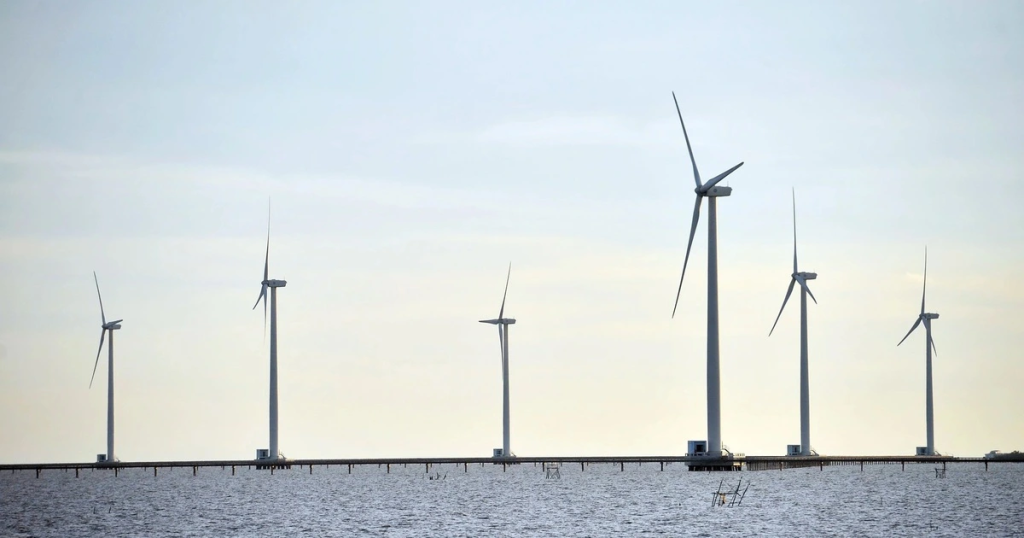
As the global demand for sustainable and renewable energy solutions intensifies, offshore wind energy (OWE) emerges as a transformative force in reshaping the energy landscape. This article delves into the legal, economic, and strategic dimensions of OWE, exploring its immense potential, the evolving legal frameworks, and its implications for nations like Vietnam aiming to lead in renewable energy innovation.
1. The rise of offshore wind energy
1.1. Global potential of offshore wind energy
Offshore wind energy has evolved from rudimentary windmills into an advanced energy source, leveraging modern technology to harness wind power from seas and oceans. With attributes like sustainability, cost efficiency, and minimal environmental impact, it is a cornerstone of renewable energy strategies worldwide. As noted in the 2024 Offshore Wind Report by the Global Wind Energy Council (GWEC), the industry benefits from widespread governmental commitments, economic growth, and industrial decarbonization efforts.
1.2. Economic and environmental benefits
Offshore wind farms offer consistent energy production with near-zero emissions during operation. They contribute to energy security, reduce dependence on fossil fuels, and create economic opportunities through job creation in manufacturing, construction, and maintenance. Globally, over 1.2 million jobs have been generated directly and indirectly by the wind energy sector, fostering regional economic growth and innovation.
2. Offshore wind energy in national energy strategies
2.1. Strategic importance
OWE plays a pivotal role in reducing reliance on traditional energy sources and ensuring energy independence. Advanced energy storage systems and innovations in turbine technology enhance reliability, making it a practical solution for meeting rising energy demands.
2.2. Alignment with global and national goals
Countries are integrating OWE into their renewable energy strategies to meet sustainability goals. For instance, the European Union aims to achieve 111 GW of offshore wind capacity by 2030, while the United States targets 30 GW by the same year. In Asia, nations like Vietnam, China, and Japan are spearheading ambitious projects to establish regional leadership in offshore wind energy.
3. Vietnam’s offshore wind energy landscape
3.1. The potential for growth
Vietnam stands as a rising star in the global offshore wind sector. With extensive coastal areas and favorable wind conditions, it ranks fourth worldwide in the number of offshore wind farms. By the end of 2023, the nation’s total wind energy capacity reached nearly 5,000 MW, and over 100 wind power plants have registered for commercial operation.
3.2. Prominent projects
Key projects, such as the Ea Nam Wind Power Complex in Ninh Thuan province and the Bạc Liêu offshore wind farm, highlight Vietnam’s commitment to renewable energy development. These ventures not only generate clean energy but also contribute to local economic growth by promoting tourism and ensuring environmental sustainability.
3.3. Foreign investment and legal framework
Foreign investors have identified Vietnam as a prime destination for offshore wind energy development. For example, Denmark’s Copenhagen Infrastructure Partners (CIP) partnered with Binh Thuan province to develop a $10 billion offshore wind project with a capacity of 3.5 GW. Such initiatives underline the need for robust legal frameworks to support foreign direct investment, safeguard environmental standards, and streamline licensing processes.
4. Legal challenges and opportunities
4.1. Regulatory gaps
Vietnam’s legal framework for offshore wind energy is still evolving. While general provisions for renewable energy exist, specific regulations governing offshore wind energy remain underdeveloped. This creates challenges for project developers in navigating approval processes, environmental compliance, and land use rights.
4.2. Policy recommendations
To capitalize on its offshore wind potential, Vietnam should:
- Develop comprehensive legislation tailored to offshore wind energy, addressing licensing, land use, and environmental impact assessments.
- Establish incentives such as tax benefits and subsidies to attract both local and international investors.
- Facilitate international cooperation for technology transfer and expertise sharing.
5. Offshore wind energy: A path to sustainable development
The advancement of offshore wind energy aligns with Vietnam’s commitment to global climate initiatives, including its pledges under the Paris Agreement and COP28. By fostering collaboration between the government, private sector, and international stakeholders, Vietnam can position itself as a leader in green energy while meeting its sustainable development goals.
Offshore wind energy represents a critical pillar in the transition to a sustainable energy future. For nations like Vietnam, embracing this renewable energy source offers not only environmental benefits but also opportunities for economic growth and technological innovation. A robust legal framework and proactive policies will be essential in unlocking the full potential of offshore wind energy, paving the way for a greener, more sustainable future.
______________________
Contact Our Legal Experts
At TLA, our experienced lawyers specialize in diverse legal fields, including criminal, civil, corporate, and family law. We provide comprehensive legal support and personalized advice.
For Expert Legal Consultation, Contact Us:
1. Lawyer Vu Thi Phuong Thanh – Director of TLA Law Firm, Hanoi Bar Association.
Email: vtpthanh@tlalaw.vn
2. Lawyer Tran My Le – Chairwoman of TLA Law Firm’s Members’ Council, Hanoi Bar Association.
Email: tmle@tlalaw.vn
Address: Floor 7, No. 6 Duong Dinh Nghe Street, Yen Hoa, Cau Giay, Hanoi
Website: https://tlalaw.vn/
Hotline: 0906246464
_LTTTra_

